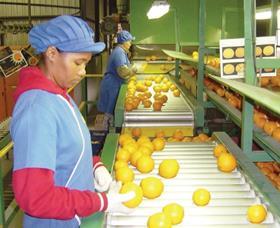
South Africa's citrus industry is learning about the Chinese market’s stringent quality standards the hard way.
Prices of South African citrus have plummeted in China over the past two or three weeks – and large stocks have amassed – after an influx of shipments unfit for this market were diverted from other export destinations, notably Russia.
From average selling prices of Yn165-170 per carton in China just over a month ago, RSA citrus prices have since buckled, with most fruit currently fetching just Yn100-110 per carton, according to Jason Bosch of importer Origin Direct Asia.
Based on the present selling prices, Mr Bosch estimated growers would be receiving only US$5 per carton FOB for average fruit. That’s below the breakeven price, which he put in the order of US$8 per carton.
Rutger van Wulfen of Hong Kong-based import company Prestige China Development (PCD), which is part owned by SAFE in South Africa, shared Mr Bosch’s concerns about the market situation.
“Exporters shouldn’t dump fruit in China that doesn’t belong here,” he told Fruitnet.com. “This can have dramatic results for all industry stakeholders, and above all results back to the growers in South Africa.”
A multitude of factors conspired to cause the crash in China, according to Mr Bosch.
South Africa’s initial predictions of a fairly normal-sized crop were then revised downwards to lower than historical levels. This, in turn, led growers and exporters to push up prices.
Cascade effect
Demand from Europe for South African citrus was sluggish until a few weeks ago, Mr Bosch added, so many growers and exporters steered more fruit into the better-performing Russian and Middle East markets.
These markets in turn came under pressure, and Russia in particular took a tumble as it was already battling excess stocks of fruit from Spain, Morocco and Egypt.
“The only strong alternative for the larger fruit that Russia was taking was Hong Kong/China, so a lot of people began focusing on this market in July,” said Mr Bosch. “After the Russian market came under pressure, shipments destined for Hong Kong and China increased dramatically. Loadings in week 31 were more than double the historical levels and shipments for week 33 were up to four times as high as figures for previous years.”
Wrong grade of fruit
Much of the fruit loaded was unfit for the China market, which has more stringent quality standards than Russia or the EU, Mr Bosch noted. “Basically we ended up with a lot of fruit that shouldn’t be here, and too much of it,” he said.
“Prices started collapsing, some importers panicked and sold fruit for whatever price they could get, some tried to store fruit and ride out the storm, but it was all too late. The damage was done.
“Buyers stopped buying because no-one knew when the price drop would end and buyers did not want to pay more than what tomorrow’s price would be. Everyone sat with – and is still sitting with – stock.”
As of last week, around 300 containers of South African citrus were filling coldrooms in China, with a further 100 containers still to arrive, Mr Bosch estimated.
Better shipping information needed
He believes the situation might have been avoided if the industry had more timely information on shipping volumes to work with.
“Unfortunately the shipping information from South Africa only becomes available around two or three weeks after the shipment date, so by the time anyone was aware what had been loaded, the containers were already being unloaded,” he said.
More direct shipments to Shanghai
The market collapse centred on the main import hub in Guangzhou, and Mr Bosch noted that a growth in the proportion of South African citrus moving directly to Shanghai this year only compounded the problem. “This took away these markets as an alternative to try and truck fruit up from Guangzhou,” he noted.
Mr van Wulfen said his company saw the problem coming, and focused its efforts on the cold-sterilised shipments direct to Shanghai at the appropriate time to avoid the worst effects of the collapse in Hong Kong and Guangzhou.
Taking the positives
Having a spread of markets across Asia also helped PCD to deal with the problems in China, he added, noting that there remained some bright spots for the South African citrus deal in the region of late. “South East Asia has been showing an extremely strong finish for Navellates from South Africa, with Indonesia being the frontrunner,” he said. “It’s a similar situation in India and Vietnam.”
Despite the disappointing results from China over the key Moon Festival period, he is also hopeful that the tail-end of the deal could pick up. 'The normal curve is for the prices of the first arrivals to start high and then lower quickly to pick up for the Moon Festival but that didn't happen this year due to the massive influx of mainly poor quality fruit,' Mr van Wulfen said. 'We have one more chance for the National Day on 1 October. Good quality fruit will still be okay.'



